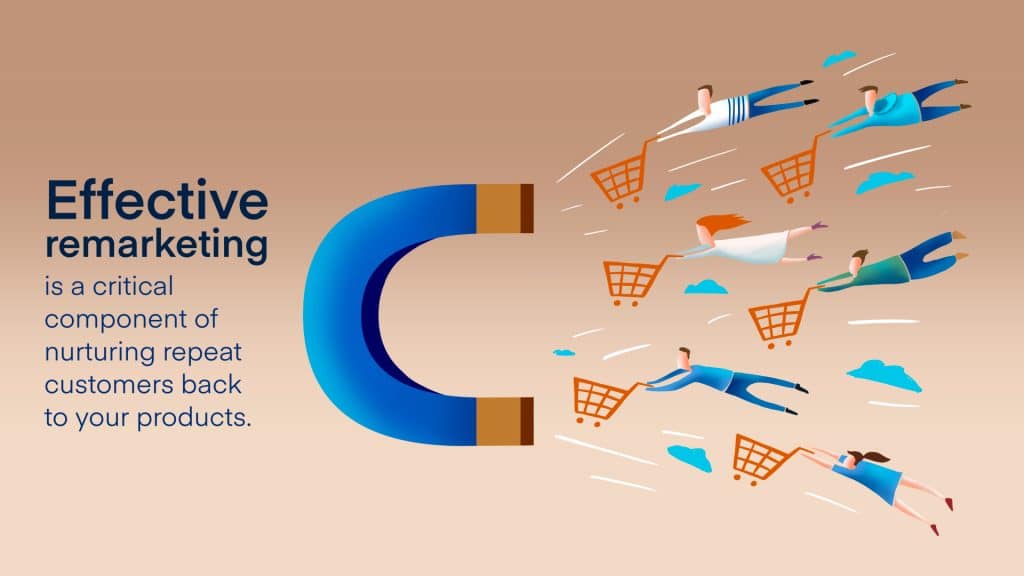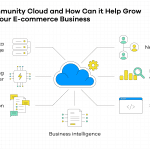
The holidays are a prime opportunity to grow your first-party ecommerce sales, but a sales dip often follows them in Q1. You can reverse this annual trend and build on your holiday success with an effective remarketing strategy.
This year, one way you can optimize your ecommerce growth in Q1 is by targeting your marketing toward customers at specific points farther down in the sales funnel. Some of the most profitable customers to market to are those who have already purchased from you.
These repeat customers are the first you need to focus on with your post-holiday marketing efforts. You should especially identify and connect with customers who made their first purchases from you during the holiday season.
Whether for themselves or as a gift for someone else, these customers found what they were looking for from your ecommerce business. With the right approach, you can turn these one-off sales conversions into long-term customers. This is the essence of remarketing.
Remarketing is one of the most successful types of marketing an ecommerce brand can take advantage of. Since the target audience you are investing in targeted ad buys and marketing campaigns for is one that you have already been able to convert, you are more likely to do so again, particularly compared to shoppers near the top of the sales funnel.
Retargeting vs. Remarketing
While these two terms are often used interchangeably, there is an important distinction between retargeted advertising and remarketing. Not only that, but since many of the most popular ecommerce advertising services also vary in how they distinguish between the terms, understanding the differences for yourself is key to ensuring that you craft the most profitable marketing campaigns you can.
Retargeted Advertisements
Retargeted advertisements target potential customers who have visited your site, seen your listings, used your app, abandoned a shopping cart, encountered your brand on social media, and/or been exposed to your ads. These are leads near the top stages of the sales funnel that have yet to convert into completed sales.
Because of the prerequisite that ad viewers are presumed to have seen and/or engaged with your brand or products in some way, retargeting is one of the most efficient ways to move potential customers from the awareness and interest stages of the buying journey to deeper stages of evaluation and engagement.
With retargeted advertising campaigns, you can create more sophisticated marketing efforts that are less about defining your brand and merchandise and more about fostering an intent to purchase.
Ultimately, success with retargeted advertising can be hit or miss, depending on the net you cast. For example, retargeting prospective customers who have abandoned carts will likely produce higher clickthrough and engagement than retargeting people who have seen your brand without interacting.
Simply put, the farther down the sales funnel the target, the better the conversion odds and the more bang for your advertising buck.
Remarketing
Remarketing is retargeted advertising taken to the next level. Instead of focusing on prospective customers, you are focusing on actual former customers. These leads have already trusted your brand and have been drawn to your products enough to convert.
Focusing on your existing customer base amplifies the benefits of retargeting campaigns in terms of improved click-through rate (CTR), cost-effectiveness, and conversion rate. Moreover, remarketing campaigns can be more personalized and selective than general retargeting.
One big reason is that completing a purchase gives customers access to additional layers of first-party data, including contact information, demographics, and behaviors. This data gives you the ability to initiate more direct marketing efforts via email, SMS, and even physical mail rather than relying on marketplace, search engine, and social media advertising platforms.
This also allows you to be deliberate and granular with who receives certain versions of your marketing materials and promotions. Coming off of one of the most successful holiday seasons the ecommerce industry has ever seen, remarketing can be your key to keeping the ball rolling into Q1 2022.

Tips for Executing a Successful Q1 Remarketing Campaign
The most important thing to know about effective remarketing is that there is no one-size-fits-all approach. The more data-driven and thoughtful your planning, the more success you are likely to have. That said, there are some crucial considerations you need to keep in mind:
Get Specific with Your Targeting
Remarketing is already focusing on a very specific subset of leads: customers who have completed a purchase. While targeting this group en masse will likely produce better CTR and conversions than more generic efforts, it still isn’t the most optimized approach.
Digging deeper into your metrics and data will allow you to achieve better odds of success. Look for additional trends, such as SKUs that sell particularly well to certain ages, genders, regions, or demographic classifications.
Identify digital behaviors, such as browsing patterns, landing pages, and time spent on-site, and how they correlate to purchasing behaviors. These specifics are useful in determining a customer’s intentions and likelihood of repeat business.
Designing offers, promotions, and content tailored to narrow sectors of your customer base shows customers that your brand is paying attention to who they are and what they want.
Cross-Sell and Upsell
Remarketing should be considerate of customers’ prior purchases. Notice popular product pairings and use them to initiate cross-selling suggestions and promotions to former customers. Providing a product or set of products as a promotional call to action is a more specific and deliberate form of marketing that could increase the odds of conversion.
Furthermore, even if items were purchased in Q4 as gifts by holiday secondary audiences, suggesting compatible products could plant the seed for future gift-giving occasions and/or spark enough interest for a gift-giver to purchase a little something for themself.
Create and Choose Purposeful Landing Pages for Remarketing Contacts
Rather than just steering customers to a homepage or a listing, you can (and should) create landing pages tailored to the promotions and customer appreciation you are trying to foster. This can create the impression that being a former customer comes with perks not readily available or accessible to the general public.
Be Timely
The longer you wait between a purchase and a remarketing follow-up, the more likely your efforts will be ignored. In most cases, the sweet spot for a remarketing follow-up is under 30 days from the last purchase. Wait longer, and you diminish the return on investment and increase metrics like cost-per-click and cost-per-conversion.
Set Limits
Not everyone who has purchased from you will do it again. You need to recognize when to cut bait and let a customer go. For example, consider excluding former customers who do not respond or interact after 90 days from your remarketing efforts.
You can consider reaching out again next holiday season or as part of larger, more general retargeting efforts, but there are one-and-done shoppers who will never re-engage—no matter how hard you try or how much you spend.
Return business is one of the brass rings of ecommerce. It can fuel your brand to scale quarter-over-quarter and year-over-year. Effective remarketing is critical to nurturing repeat customers, reintroducing them to your products, and stoking the loyalty that increases your bottom line.
The Descartes Sellercloud and its modules are available year-round to help ensure that you can deliver optimal ecommerce experiences for your customers, both new and old.
Contact us for a free demo. See how our catalog, fulfillment, warehousing, and tracking tools make it simple to scale your business across first- and third-party platforms.




